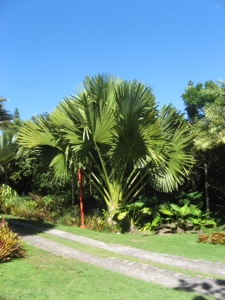Now sitting in the cockpit waiting for Follyfin to be hauled out of the water. Yes we are going home for a holiday! After 3 months away, we feel in need of a change… if only to arrange to see doctor, dentist, optician, hairdresser, hearing consultant etc. “Are you going deaf?” I hear you ask. Well, not exactly but each of us increasingly finds him or herself having to repeat the words that have just been said to the other! Is this because we have stopped listening to the other, or are we going deaf? Well, after almost 42 years of marriage, it could be either. Hearing tests for both should provide the answer.
The island where we are now based is shared between the French - occupying the northern half named St Martin - and the Dutch - occupying the southern half named Sint Maarten. So far we have only sampled the Dutch side as this is where the boatyard is located. In reality, the majority of people we have heard speak are American, reflected in the island-wide currency being US dollars. This island might also be known as ‘Holidaymaker Central’. It is packed with high-rise hotels and holiday apartments and all the pubs and clubs that go with them. As well as beautiful beaches it also has the one of the largest land-locked lagoons - all 12 sq.miles of it - in the Caribbean, and in which there are numerous marinas, making it popular with superyachts and their owners (who are a rare breed, hardly ever spotted). Access is through a lifting bridge four times a day. But the lagoon is at its best early in the morning...
We chose to stay anchored outside in Simpson Bay until the time came to be lifted out. This meant that we could still swim but had to travel quite a long way by dinghy into the lagoon to do any business, shopping etc. On one trip in we had the surprise of our lives when just a few metres from our dinghy, whilst still out in the bay, a large sting ray jumped completely clear of the water - tail and all - and splashed back beside us! Regret no photographic evidence but the image is indelibly imprinted on my memory. So lucky to have seen such a rare sight.
Here in Bobby’s boatyard, we found ourselves berthed next to the ‘Treasure Seeker’ pirate ship.
Sharing a few beers with the current owner, an American coincidentally named Ray, we found out that this amazing steel-hulled vessel was originally built in Wisconsin in 1955 as a car ferry. Ray started his Pirate Ship enterprise 8 years ago with another similar boat which sank in the Caribbean Sea (it's a long story). So successful was the business that he bought the another pirate ship, the current one, 4 years ago and ‘sailed’ it down inland waterways to Florida where he set up again. The ‘masts’ of this one are actually recycled New York lamp posts! Not seeing eye to eye with the authorities in Florida, Ray, his son and 3 other hearties sailed the Treasure Seeker down through the Bahamas to the US Virgin Islands but on the way it foundered on a reef doing $50,000 worth of damage. Moving on down here last year to Sint Maarten to ply their pirate trade, the boat was blown ashore during a hurricane. It is now undergoing extensive repairs and guess what … is up for sale! Anyone want a pirate ship?
Since I began this post, Follyfin has been hauled out
So Follyfin is now on dry land. Phew!
We fly out on Wednesday via Puerto Rico. A brief stopover in London with family Hodgkinson and then back home to Yorkshire. Brrr! Not looking forward to the cold weather - every day it's 28-30°C here, sun and bright blue sky - but it will be lovely to be home again… only briefly though as our odyssey continues from the beginning of April to the Virgin Islands, Turks and Caicos, Bahamas and thence the US east coast to New York and points north. At least that's the plan!


























